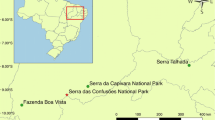Abstract
Tool use and transport represent cognitively important aspects of early hominid evolution, and nonhuman primates are often used as models to examine the cognitive, ecological, morphological and social correlates of these behaviors in order to gain insights into the behavior of our early human ancestors. In 2001, Jalles-Filho et al. found that free-ranging capuchin monkeys failed to transport tools (stones) to food sites (nuts), but transported the foods to the tool sites. This result cast doubt on the usefulness of Cebus to model early human tool-using behavior. In this study, we examined the performance of six captive tufted capuchin monkeys (Cebus apella) in a tool transport task. Subjects were provided with the opportunity to transport two different tools to fixed food reward sites when the food reward was visible from the tool site and when the food reward was not visible from the tool site. We found that the subjects quickly and readily transported probing tools to an apparatus baited with syrup, but rarely transported stones to a nut-cracking apparatus. We suggest that the performance of the capuchins here reflects an efficient foraging strategy, in terms of energy return, among wild Cebus monkeys.
Similar content being viewed by others
References
Boesch C, Boesch H (1983) Optimisation of nut-cracking with natural hammers by wild chimpanzees. Behaviour 83:265–286
Boesch C, Boesch H (1984) Nut-cracking behavior of wild chimpanzees, Ivory Coast. Int J Primatol 5:398
Boesch C, Boesch H (1990) Tool use and tool making in wild chimpanzees. Folia Primatol 54:86–99
Boinski S (1988) Use of a club by a wild white-faced capuchin (Cebus capucinus) to attack a venomous snake (Bothrops asper). Am J Primatol 14:177–179
Boinski S, Campbell A (1995) Use of trill vocalizations to coordinate troop movement among white-faced capuchins: a second field test. Behaviour 132:875–901
Boinski S, Quatrone RP, Swartz H (2001) Substrate and tool use by brown capuchins in Suriname: ecological contexts and cognitive bases. Am Anthropol 102:741–761
Call J, Tomasello M (1995) Use of social information in the problem solving of orangutans (Pongo pygmaeus) and human children (Homo sapiens). J Comp Psychol 109:308–320
Costello MB, Fragaszy D (1988) Prehension in Cebus and Saimiri: 1. Grip type and hand preference. Am J Primatol 15:235–245
Fernandes ME (1991) Tool use and predation of oysters (Crassostrea rhizophorae) by the tufted capuchin, Cebus apella apella, in brackish water mangrove swamp. Primates 32:529–531
Fragaszy D (1990) Early behavioral development in capuchins (Cebus). Folia Primatol 54:119–128
Izawa K, Mizuno A (1977) Palm-fruit cracking behavior of wild black-capped capuchin (Cebus apella). Primates 18:773–792
Jalles-Filho E, Grassetto R, da Cuhna T, Salm RA (2001) Transport of tools and mental representation: is capuchin monkey tool behaviour a useful model of Plio-Pleistocene hominid technology? J Hum Evol 40:365–377
Lawick-Goodall J van (1971) In the shadow of man. Dell, New York
Panger MA (1998) Object-use in free-ranging white-faced capuchins (Cebus capucinus) in Costa Rica. Am J Phys Anthropol 106:311–321
Phillips KA (1998) Tool use in wild capuchin monkeys (Cebus albifrons trinitatis). Am J Primatol 46:259–261
Savage-Rumbaugh E (1994) Hominid evolution: looking to modern apes for clues. In: Quiatt D, Itani J (eds) Hominid culture in primate perspective. University Press of Colorado, Niwot, Colo.
Schaik CP van, Knott CD (2001) Geographical variation in tool use on Neesia fruits in orangutans. Am J Phys Anthropol 114:331–342
Schaik CP van, Pradhan G (2003) A model for tool-use traditions in primates: implications for the coevolution of culture and cognition. J Hum Evol 44:645–664
Schaik CP van, Fox EA, Fechtman LT (2003) Individual variation in the rate of use of tree-hole tools among wild orangutans: implications for hominin evolution. J Hum Evol 44:11–23
Sitompul AF, Fox EA, van Schaik CP (1998) Intelligent tool use in wild Sumatran orangutans (Pongo pygmaeus albelii). Am J Phys Anthropol [Suppl] 26:202–203
Westergaard GC (1996) The lithic technology of Cebus apella and its implications for brain evolution and the preconditions of language in Homo habilis. Behav Brain Sci 19:792–793
Westergaard GC (1999) Token-mediated tool use by a tufted capuchin monkey. Am J Primatol 49:114
Westergaard GC, Fragaszy D (1987) The manufacture and use of tools by capuchin monkeys (Cebus apella). J Comp Psychol 101:159–168
Westergaard GC, Kuhn HE (2001) Skeletal evidence for precision gripping in Cebus apella. Hum Evol 16:137–142
Westergaard GC, Suomi SJ (1995) The manufacture and use of bamboo tools by monkeys: possible implications for the development of material culture among East Asian hominids. J Archaeol Sci 22:677–681
Westergaard GC, Suomi SJ (1996) Hand preference for stone artefact production and tool-use by monkeys: possible implications for the evolution of right handedness in hominids. J Hum Evol 30:291–298
Westergaard GC, Suomi SJ (1997a) Capuchin monkey (Cebus apella) grips for the use of stone tools. Am J Phys Anthropol 103:131–135
Westergaard GC, Suomi SJ (1997b) Modification of clay forms by tufted capuchins (Cebus apella). Int J Primatol 18:455–467
Westergaard GC, Greene J, Babitz M, Suomi SJ (1995) Pestle use and modification by tufted capuchins (Cebus apella). Int J Primatol 16:643–651
Westergaard GC, Lundquist AL, Kuhn HE, Suomi SJ (1997) Ant-gathering with tools by captive tufted capuchins (Cebus apella). Int J Primatol 18:95–103
Westergaard GC, Cleveland A, Rocca A, Wendt E, Brown M (2003) Throwing behavior and the mass distribution of rock selection in tufted capuchin monkeys (Cebus apella). Am J Phys Anthropol [Suppl] 36:223
Author information
Authors and Affiliations
Corresponding author
Rights and permissions
About this article
Cite this article
Cleveland, A., Rocca, A.M., Wendt, E.L. et al. Transport of tools to food sites in tufted capuchin monkeys (Cebus apella). Anim Cogn 7, 193–198 (2004). https://doi.org/10.1007/s10071-004-0213-3
Received:
Revised:
Accepted:
Published:
Issue Date:
DOI: https://doi.org/10.1007/s10071-004-0213-3




